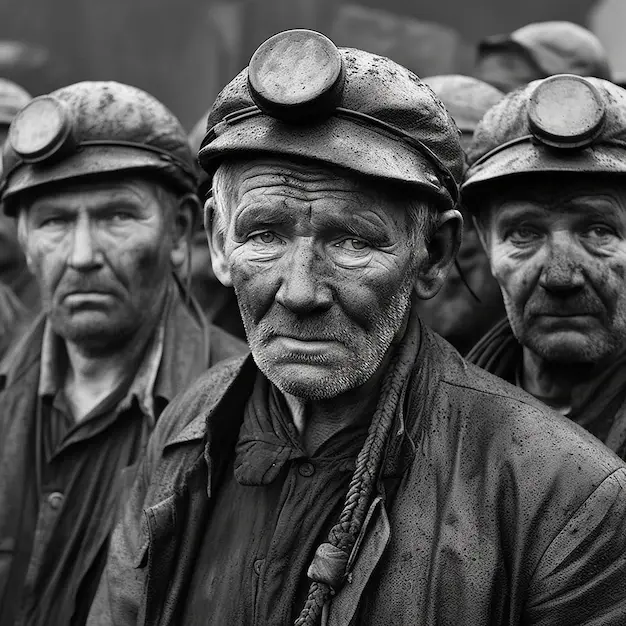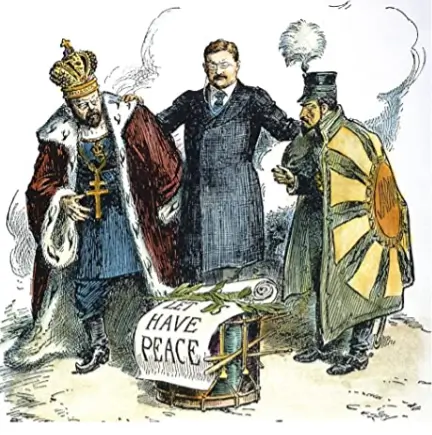Is the Coal Mining Industry A Jewish Tool of Mass Oppression?
MALIGNANT SHADOWS
TALES OF HORROR FROM THE ROTHSCHILD MINES
Preface:
What follows is what I have learned very often from eyewitnesses and participants, and what I have personally experienced while growing up in the wake of what some have called the “Kings of the World.” Using a Chess analogy: If Evil Aliens are represented by the King, then International Jewry is represented by the Queen. The King is of absolute importance in the game of chess, but the most powerful piece over the course of any chess game is the queen.
Part One – The Devil Comes to Appalachia
One of the results of the post-Civil-War “Reconstruction Era” was the people who lived in the mountain areas that supported the Confederacy found themselves stripped of their citizenship, their property, and their property rights. This process of dispossession that included stripping people of land ownership and citizenship also applied to the Eastern Band of The Cherokee Nation who lived in Western North Carolina. This same routine was also leveraged onto a number of the older families who lived around where I grew up; although, this sort of bad treatment did not actually happen to any of my relatives — fortunately.
During the Reconstruction Era, any land with vacated titles was picked up by Northern Carpetbaggers, and this seized land was allegedly earmarked for distribution to former slaves; however, what is not widely known is that these Northern “Carpetbaggers” were acting as Rothschild agents. Across the South during the “Reconstruction Era,” the Rothschilds were on the lookout for land that contained valuable mineral deposits which they could acquire by hook or by crook then ruthlessly exploit for a handsome profit.
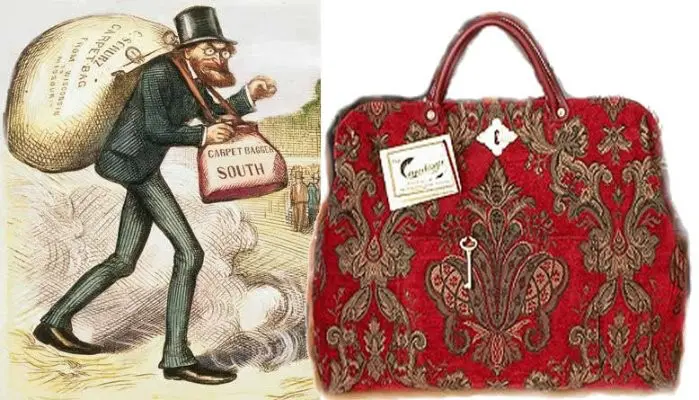
The image seen above is furnished courtesy of Noel Niddrie on Linkedin.com
The now-destitute White Southern families who wound up losing their family lands after the Second American Revolution had been self-sustaining and they had lived on their bequeathed land for generations, but now they were forced to go to work for the Jewish Rothschilds clan of financial pirates. Once bereft of their ancestral land holdings, these Appalachian Whites wound up working under the most atrocious and dangerous conditions as wage slaves while earning just barely enough to survive. These “Red Shields from Frankfurt” were only interested in the Appalachian Mountains because these parts hold vast deposits of very valuable coal which lie under the ground from one end of the Appalachians in Central Alabama to the other end of this mountain ranges of New Brunswick, Canada.
The Rothschilds normally operated through fronts such as holdings companies or by financing quasi-independent mine operators. It was somewhat unusual to see any coal mines in Appalachia that were directly owned by the Rothschilds like the mines where I was from, so the Rothschilds typically used the name of their “French” branch of the clan to obfuscate who really owned the coal mines of Appalachia.
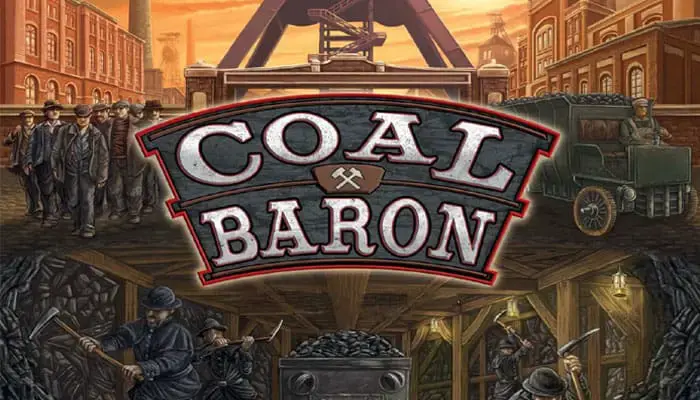
The image seen above shows a box cover for the board game called Coal Baron. The image seen above is furnished courtesy of ultraboardgames.com
The horror stories that surround old Appalachian coal mines can be laid squarely at the doors of their overwhelmingly Jewish owners and financiers, and this state of affairs extends even into the Coalfield Region of Western Pennsylvania where conditions for miners were every bit as bad.
Special mention must be made for the worst of the worst for the coal mining industry, and that would be Harlan County, Kentucky. Many is the time that I have heard a common phrase, including hearing this phrase from many coal mining relatives of mine when I was young, “You’ll never leave Harlan alive.” If a man made the mistake of going into the mines there in Harlan County, then it was considered a veritable death sentence for the miner in question. The destitute Whites from Appalachia who arrived at the Harlan coal mines were usually already weakened by hunger and malnourishment, so many members of coal-mining families were carried away by the always rampant sickness that lingered in the mining camps.
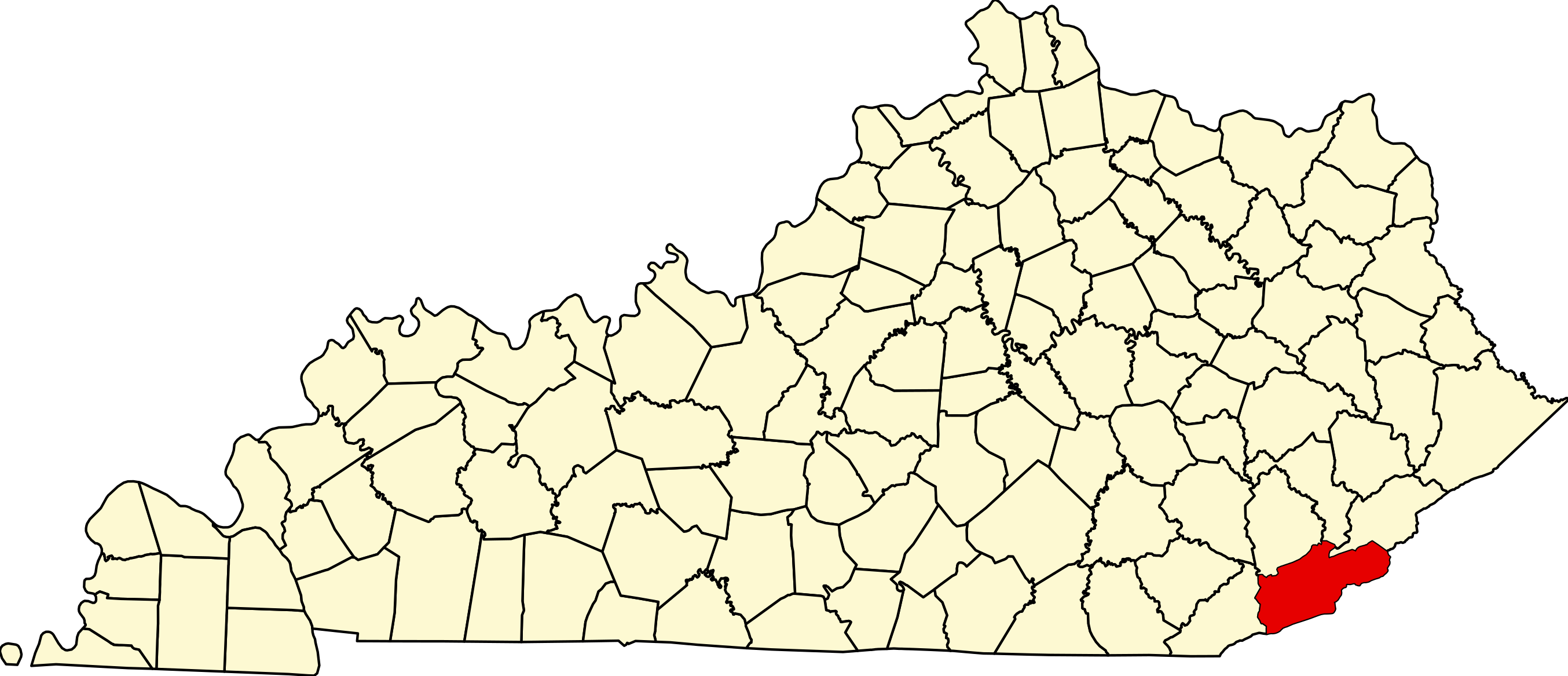
The image above shows Harlan County imposed upon a map of the state of Kentucky. Image courtesy of wikipedia.org
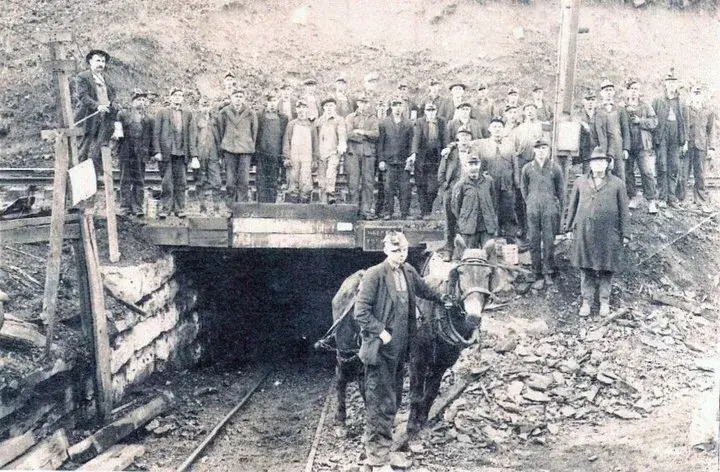
The image above shows an old archival photograph of an old Harlan County coal mine. The image seen above is furnished courtesy of kygs.org
Soul-crushing institutionalized poverty was what drove men against their wills into the Jewish-owned coal mines of Appalachia. The proposition for old-time Appalachian coal miners often boiled down to this: “A man and his family might manage to survive working in the coal mines, but they would not survive unemployment.” As a byproduct of being landless and always poor, many coal miners had to live in the mining camps that were established by Jewish-owned mining companies. In these mining camps, greedy and unprincipled employers took back a good part of every miner’s wages in rent.
My daddy’s people were fortunate because they were able to engage in subsistence farming on their own land for about half of each year, so they only worked in the coal mines while they were periodically unable to make a go at farming. Luckily, my daddy’s kin lived on land that was too remote and inaccessible to have been easily seized from them. The stage is now set for that largely suppressed and forgotten period of American domestic history which is called THE COALFIELD WARS. The Coalfield Wars started when the Rothschilds created a smoldering volcano that was ready to erupt, and this smoldering caldron ran from Northeastern Alabama and Northwestern Georgia all the way to Western Pennsylvania.
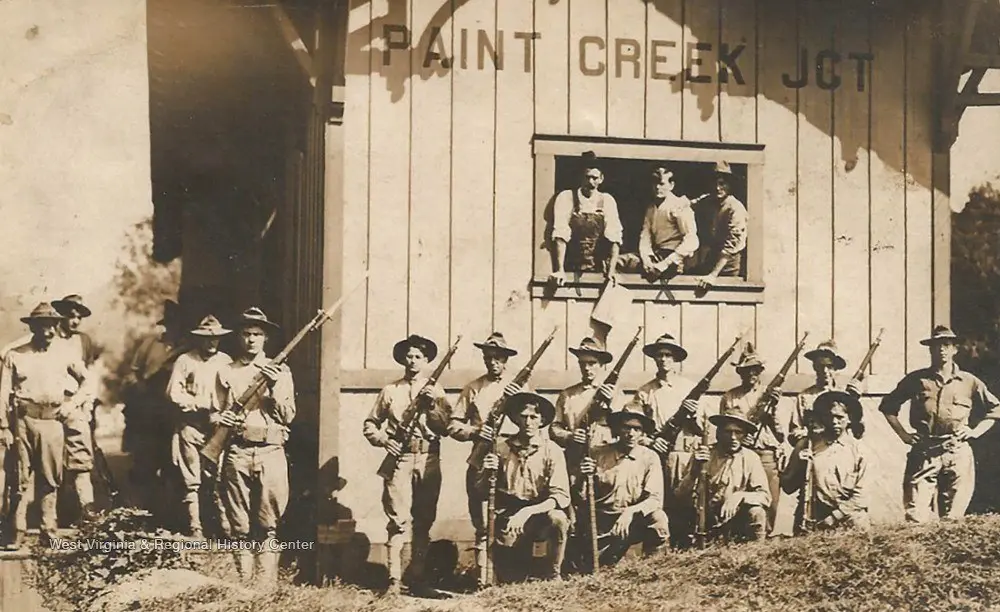
The image seen above shows armed State Troopers at Paint Creek Junction, West Virginia in 1913. This image was taken to document the Paint Creek-Cabin Creek Strike which took place during 1912 and 1913 in Kanawha County. The image seen above is furnished courtesy of nps.gov
Part Two – The Coalfield Wars
The term “Coalfield Wars” refers to the widespread violence that surrounded initiatives to organize the coal miners of Appalachia and Pennsylvania into a labor union. This effort to organize coal miners into labor unions lasted for decades and ran with varying intensity. The total number killed in this conflict is unknown, but it was no doubt quite large. These efforts to unionize on the part of American coal miners happened because the miners were backed into a corner with no legal way of getting their all-too-real grievances addressed. For these miners, forming labor unions was a matter of “fight or perish.”
Certainly, Jewish Bolsheviks tried to take advantage of the situation with labor unrest in North America’s coal mines by fomenting for a full-blown revolution. The old Coalfield Wars are yet another case where international Jewry first creates a problem then deceives everyone by trying to sell another bogus “solution” of their own devising to a problem which they created in the first place that inevitably leaves the Jews in charge of everything either way.
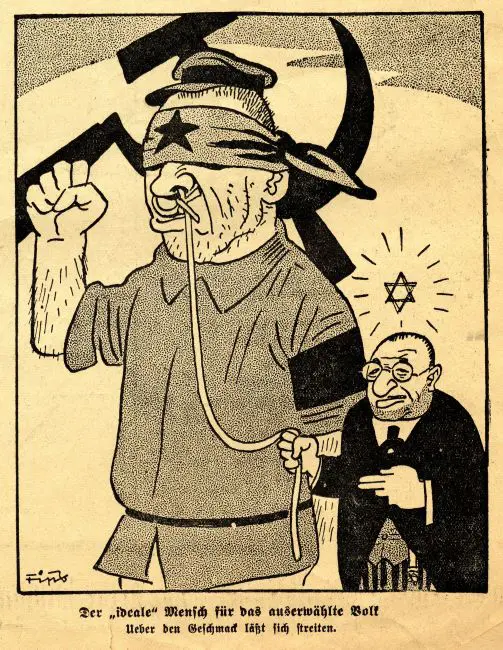
Image courtesy of lekcja.auschwitz.org.
Matters in the Coalfield Wars came to a head with the Battle of Blair Mountain which took place in West Virginia. This particular battle involved combatants numbering in the thousands and total casualties numbering in the hundreds. On that day, the miners fought against an alliance of the US Army, the West Virginia State Militia (National Guard), and a private army of mercenaries that was funded by the mine owners themselves.
The army of private mercenaries who were working under the pay of Appalachian mine owners included a large number of Christian ministers who considered it their Christian duty to help put down the striking coal miners that very often were members of their own congregations. These Christian preachers worked to suppress any attempts for the miners to unionize because these preachers believed that God had put the mine owners in charge for good reason. The Christian preachers who sided with the mine owners during the Coalfield Wars believed that the miners were required to submit to the mine owners by way of divine law. Guess who was paying the salaries of these crooked Christian preachers?
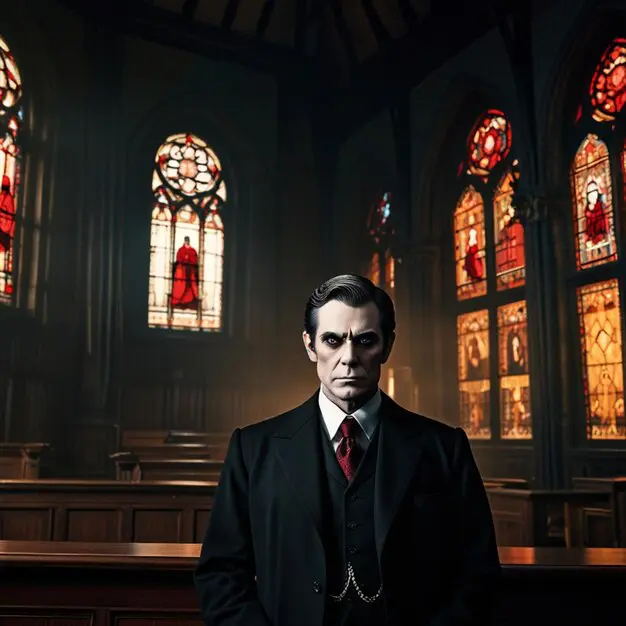
Image courtesy of freepik.com
When analyzing the historical backdrop to the Coalfield Wars, we can see that organized Christianity was leveraged by Jews as a mechanism for social control. This particular situation still has not changed to this day because the general population of Appalachia still tends to be poorly educated and easy to manipulate with the superstition that is purveyed by wolves who are wearing sheep’s clothing. The poor education of Appalachia’s population and the rest of the Zio-American Empire in general comes about by deliberately starving public schools of funds and by making private schools too expensive for most families to afford.
After the Battle of Blair Mountain, the realization came to the mine owners that things were teetering on the brink of a full-blown rebellion, not just in Appalachia, but in the Western Mountains of Pennsylvania as well. So, with trouble brewing across the coal-mining country, John L. Lewis was brought forth to head the UMW (United Mine Workers) union to serve as a safety valve for rising violent tensions. John L. Lewis’s job was basically just to address some of the most egregious grievances that the miners had while still leaving the Jewish Capitalist system fundamentally intact.
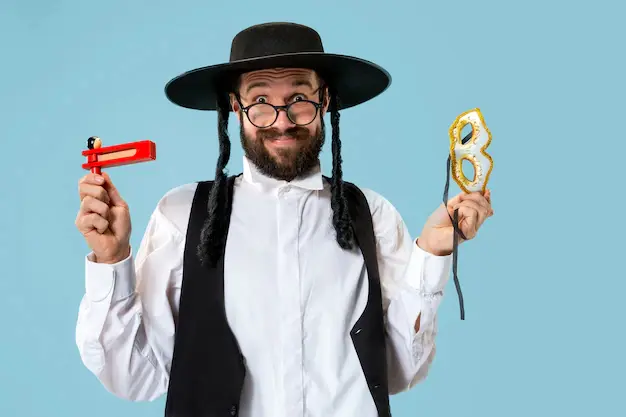
Image courtesy of freepik.com
The Draft (Conscription) in World War I hit the mountains of Appalachia particularly hard. In this case, poor White men from Appalachia were made to fight against their will in a very unpopular war. In Western North Carolina, the force that was used to conscript unwilling soldiers was literal physical force and many young men never returned from the trenches of World War I. Legalizing the formerly illegal UMW union was in part done to maintain this supply of unwilling cannon fodder for the American Army on the Western Front. By the end of “The Great War,” this belated conflict produced a large number of Appalachian men who were actually sympathetic to Germany who also became convinced that they had been forced to fight on the wrong side. The drafted and unwilling Appalachian soldiers who fought in World War I developed a great deal of respect for the Germans while they grew to detest their erstwhile allies.
There were not very many Blacks in the Appalachian Mountains during the 19th and early 20th centuries, but the Blacks who did live in Appalachia in those years also tended to be miners and they went through the same hardships as the Whites. The same thing can also be said for the Eastern Band of The Cherokee Nation. Cherokee miners and White miners stood shoulder to shoulder in the mines and in the union halls.
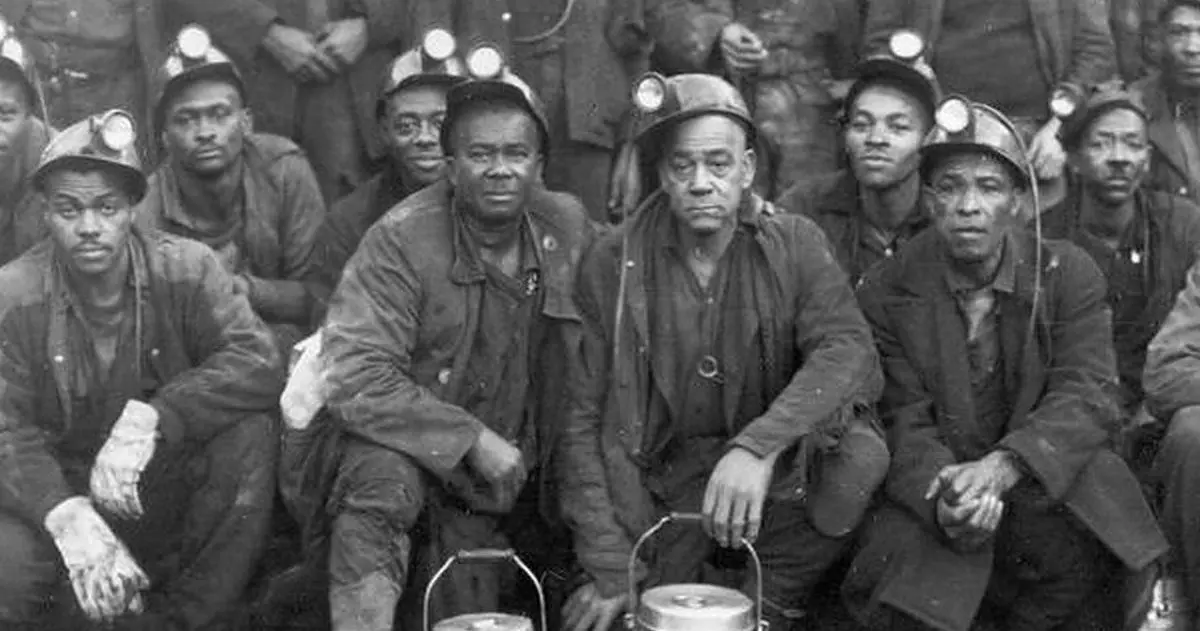
The image above shows a group of Black coal miners in West Virginia. The photo seen above was taken in 1919. Image courtesy of storytellingcenter.net
A word must be said about Black and White racial conflict at the time. On many occasions, but by no means on all occasions, conflict between Whites and Blacks in the coalfields was fomented by agent provocateurs who were working for the owners of mines and mills. These agent provocateurs would infiltrate both sides then, they would instigate to get both groups to fight against each other in order to prevent everyone from combining together against the mine owners.
For example, a Black Man would stab a White Man for no reason, then at around the same time, a White man would stab a Black man for no reason. The Blacks and Whites who were already very suspicious of each other at the best of times would then fight with one another after a deliberately planned and deliberately orchestrated attack would take place. These planned acts of sabotage were designed to prevent any coordinated and concerted actions to be taken against the mine owners by either Blacks or Whites. In such cases, unbeknownst to either side, the stabbers who had instigated these conflicts were always conveniently long gone once the fighting started, so no one every really knew that these stabby men were actually working for the mine owners the whole time.

The image seen above is furnished courtesy of Jump-off-a-building on deviantart.com
Part Three – Rothschilds and Railroads
The Rothschilds needed to have railroads to haul their coal away from the mines to where it was produced and the coal that was mined across Appalachia was used fuel the steel mills around Chattanooga, Tennessee and Birmingham, Alabama. The Rothschilds arranged for L&N Railroad (Louisville & Nashville) to build a new railroad through the area that was close to their mines around where I am originally from, but I do not know exactly who owned L&N and the steel mills; however, these companies obviously had to be closely connected to the Rothschilds. In those years, specifically the 1890’s, the railroads literally ran the Alabama State Government in Montgomery and now the Alabama state government is largely under the thumb of big Jewish-owned insurance companies.
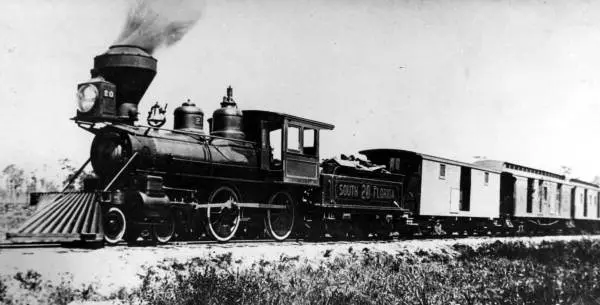
The image above shows a photograph of an old steam train that was taken in 1940. The image seen above is furnished courtesy of floridamemory.com
The Railroads first sent out surveyors and engineers to locate the best rights-of-way for any future rail lines, then the state of Alabama would declare Imminent Domain over any land that had been recently surveyed. After the state declared Imminent Domain over land where a rail line was set to run, their next move was always to send in the State Militia (National Guard) in order to seize the land and clear the former owners off of it. These evicted persons being poor White farming families, the land was seized at gunpoint without it being paid for, and these seizures typically happened with only about an hour’s worth of warning being given. In such cases, many families lost everything that could not be moved quickly.
After being evicted from their ancestral homesteads at gunpoint, such events left these White Appalachian families destitute, homeless, and forced to live out in the woods until a permanent place to residence could be obtained. After a family was evicted, the state then sold this forcefully confiscated land to the railroad owners for $1.00 an acre which was virtually nothing considering what the soon-to-be values of these property were (from eyewitnesses and survivors).
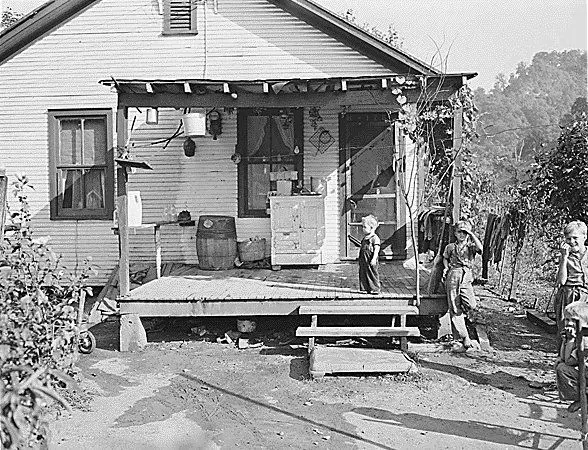
The image above is furnished courtesy of Roger Philpot on pinterest.com and it shows an old Appalachian farmhouse in West Virginia.
After the land that was slated for building a rail line was surveyed and confiscated from its former owners, then Black workers were brought in to do the actual labor of building the railroad, that is, so as long as the work was taking place above ground. Black works were used to build most parts of rail lines because it had already become too dangerous to use Irish laborers. Irish laborers were consider to be too dangerous to use because too many of them had fought The Crown back in Ireland as part of the IRB, the IRA, the Fenians, and the United Men of Ireland. The Blacks were chosen to build railroad lines because they were much easier to control. As had been the case with the Irish laborers preciously, the Black laborers were barely paid, and oftentimes they were outright cheated, overworked, and treated worse than animals while being driven to toil by trigger-happy and gun-toting thugs.
The men who worked as enforcers for the rail companies were the same class of men that would later act as slave-drivers for a number of wealthy farmers during World War II, except during World War II, the victims of such slave-driving would be German and Italian POWs who were rented out by the US Government to large farmer that had political connections. Very often, if one of these “Straw Bosses” that oversaw rail line construction projects became dissatisfied with a Black worker, then he would just shoot that worker and pocket any money which was coming to him. Back in those days, there were aways plenty more Black workers where each laborer came from. My Daddy once showed me a secluded woodland area where an unknown but quite large number of these Black laborers were buried as he informed me about what had happened.
When a rail line came to a mountain where tunneling was required, then the rail line would proceed to fire all of the Blacks and afterwords bring in a bunch of Chinese workers by way of California. Line-buiding experience that was gained from projects in the Western states uncovered the fact that Chinese made better tunnelers than Blacks. If anything, the Chinese workers were treated even worse than Blacks, except the Chinese were not routinely shot down like dogs.
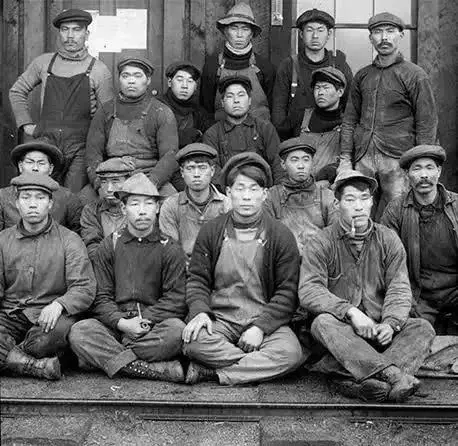
The image seen above shows Chinese railway workers who were building the old Transcontinental railroad. Image courtesy of N1GHT-MOON-UN1CORN on the r/interestingasfuck forum on reddit.com
When used to build rail lines, Chinese workers were usually malnourished and they were also frequently very sick. Chinese workers were also sick and malnourished while being mercilessly forced to work. Given what working and living conditions were like for rail road builders, many men died during every big rail-building project. To add insult to injury, the pittance wages that were given to many railroad builders were normally stolen by their supervisors whether these workers were dead or alive. Many Chinese men signed up to work on railroad-building projects because they were desperate to escape the crushing poverty that they and their families had known in California.
These unsuspecting Chinese men were lured eastward by promises of good jobs, and probably most of these men were really just being lured to their doom. The families of many missing Chinese railroad builders never learning anything about what happened to their relatives. The ones that did manage to survive working on railroad-building projects did so with broken health and continued destitution. Once these rail line tunnel was complete, the Chinese workers who were brough in for this specialty work were all fired and Blacks were once again brought in to resume the work.
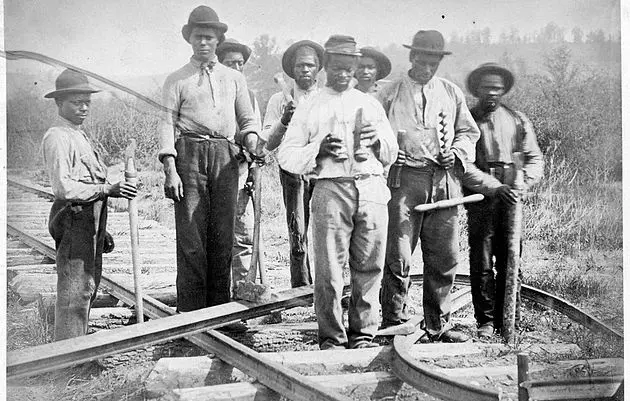
The image posted above is furnished courtesy of whatshernameposcast.com
While building a rail line near to the town where I am originally from, at one end of the tunnel the mountain was very steep, so debris kept sliding down the incline and blocking the tunnel. To prevent this sliding debris from rendering the rail line impassible, the railway builders had to pour a large concrete apron around one entrance to this tunnel in order to stop sliding debris on the mountainside from blocking the rail line. In the process of pouring this cement tunnel apron for the rial line five Chinese laborers became sick and died. The mistreatment of Chinese railroad builders is documented in the library of Jacksonville State University in Jacksonville, Alabama.
The part about the POWs being used as slave labor has been verified by numerous eyewitnesses, including My Own Mother. My father once took me to a place where these German and Italian slave workers had been housed in conditions that were meant to bring as much suffering as possible by way of having little ventilation while the weather was stiflingly hot in the summer and having no insulation while the weather was frigidly cold in the winter.
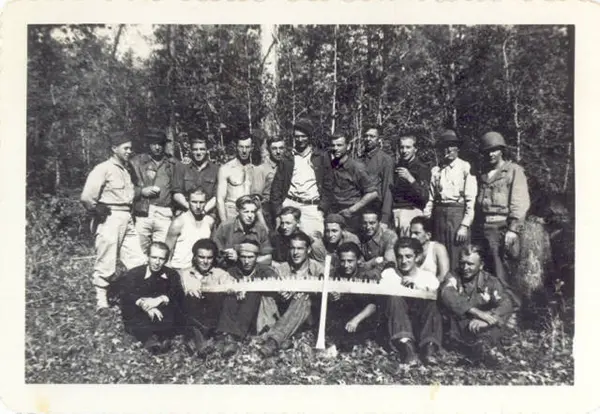
The image above shows a group photo of German POW who were forced to labor in Louisiana from 1942 to 1946. The image above is furnished courtesy of 64parioshers.org
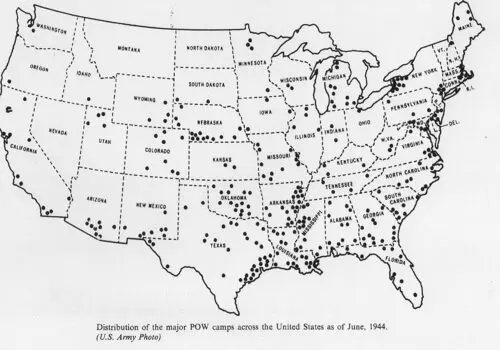
The map above shows German POW labor camps in the continental United States. According to wikipedia.org’s official entry on German POWs in North America, around 400,000+ German soldiers were sent to labor in North America during the years of World War II> Image courtesy of wikipedia.org.
Part Four – Personal Rambles and Talking with the Natives
I spent much of my time exploring the land around where I lived while growing up, and this exploration starting close to my home during my pre-elementary school years, then these explorations went much further afield as I grew older. My family was driven off their land like so many others by a combination of government and banking connivance along with the callous plotting of strip-mining coal companies. In addition to the machinations of coal companies and big banks, profit-obsessed food processors helped to ruin many small farms. After our ancestral family land, my family moved to a nearby town.
When I was nine, I first began to hear about the Rothschild Mines. I could see even then that the land around the town where my family moved had been environmentally devastated because the local vegetation looked stunted and deformed. The wildlife around the town where I and my family lived, which had previously teemed in the woods, was almost all gone at that time and what was left did not look altogether healthy. Despite all the environmental devastation that I saw, the opossums seemed to be doing well enough along with the dirty and vicious gopher rats which infested parts of the town and swarmed into the abandoned mine shafts underground. I saw one gopher rat that was a good foot and a half long, and my mother saw one that was almost twice as big running across our yard on one occasion.
The water, and there was a lot of it in the numerous drainage ditches around town, was heavily polluted by runoff from the mines as well as being filled with various organisms that could cause serious illness. The well from which the town got its water would eventually be condemned by the State Health Department because it was too contaminated.
There were another kinds of animals that also did pretty well for themselves in my old home town despite the horrible local pollution, and one such animal is a holdover from the Age of Dinosaurs which is called the Snapping Turtle. The snapping turtles lived in the ditches that were filled with filthy water and they preyed on the gopher rats for food.
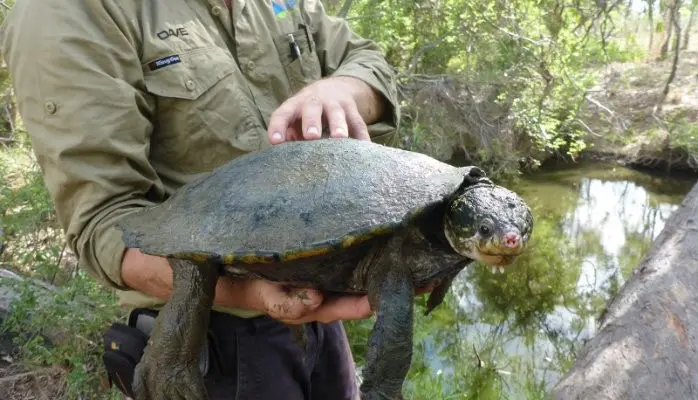
The image above shows a Southern Snapping Turtle. The image seen above is furnished courtesy of David Moore on Linkedin.com.
These local snapping turtles are renowned across the Southeast and the Lower Midwest in the United States for their ferocity from Native American times up to the present. These turtles have massive jaws that kind of resemble those of metal shearing machines. These turtles can bite in the blink of an eye and they can bit with bone-shearing force. In a flash they can stick their neck out from inside their protective shells and clamp down on somebody who had gotten too close. I have known of people losing parts of their hands and feet to the bites of these Southern snapping turtles. I once saw a particularly large snapping turtle with a shell that was 2+ feet across get hold of a huge gopher rat. Like I said, these turtles are like something from The Age of Dinosaurs.
Now we come to the human wreckage. Ex-miners, whose numbers were not small, often died of Black Lung. Black Lung involves dying a slow wasting type of death as a person’s long-suffering lungs fail because they are clogged with fine coal dust. Dying of Black Lung is essentially a death by suffocation. I lost a very good friend who helped me through a really bad time to Black Lung. Other men may not have died of Black Lung, but there were still crippled, mangled, or tattooed by the coal.
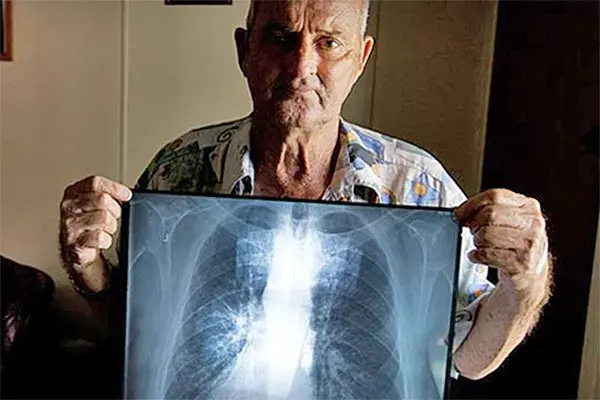
The image a one is furnished courtesy of qmeb.com.au
Tattooed By the Coal
What happens when one is stuck by coal fragments while one is shooting (dynamiting) the coal faces the sit deep underground? Well, being hit by a large enough fragment of coal can kill or decapitate a man, but being hit by smaller pieces of flying coal can just leave a crater in a person’s skin, kind of like the kinds of marks that are left over from gunshot wounds.

Image courtesy of Aaron Pauley on X.com
Sometimes, coal dust that impacts a person’s skin a high velocity can leave the impacted skin permanently pitted by what resemble blackheads, but these marks are actually left by high-velocity coal dust. My Uncle Elbert, who was actually my paternal grandfather’s brother, had his face tattooed by coal dust. He was a great and open admirer of Adolf Hitler. He, along with my Daddy, launched me on my path as a truth-seeker, while I was only nine. Then there were the women, “The Miners Wives” who were left to look after their sick and ailing coal-miner husbands, sometimes for decades. Coal mining wives cared for men who were partially or totally crippled, and most of these poor men were also dying of Black Lung in their later years; however, these Appalachian coal-mining wives were never wavering, never complaining, and never bitter about their late-life duties.
Once, when I was sixteen, I spent much of an afternoon with an old miner and his wife at my father’s suggestion. Both the husband and wife were in their early 80’s at that time, and the husband started working in the mines at the age of nineteen, at about the same time that this couple were married. The old man told me that his wife had been the most beautiful woman in several counties when she was young; however, a year after they were married the man was injured in a mining accident which left him confined to a wheelchair for life. As he told me this, the wife was in another room doing housework. After telling me about his great misfortune, he looked in her direction, and with tears in his eyes, he said, “She could have had any man she wanted. She was that beautiful. But she stayed with me and never complained.”
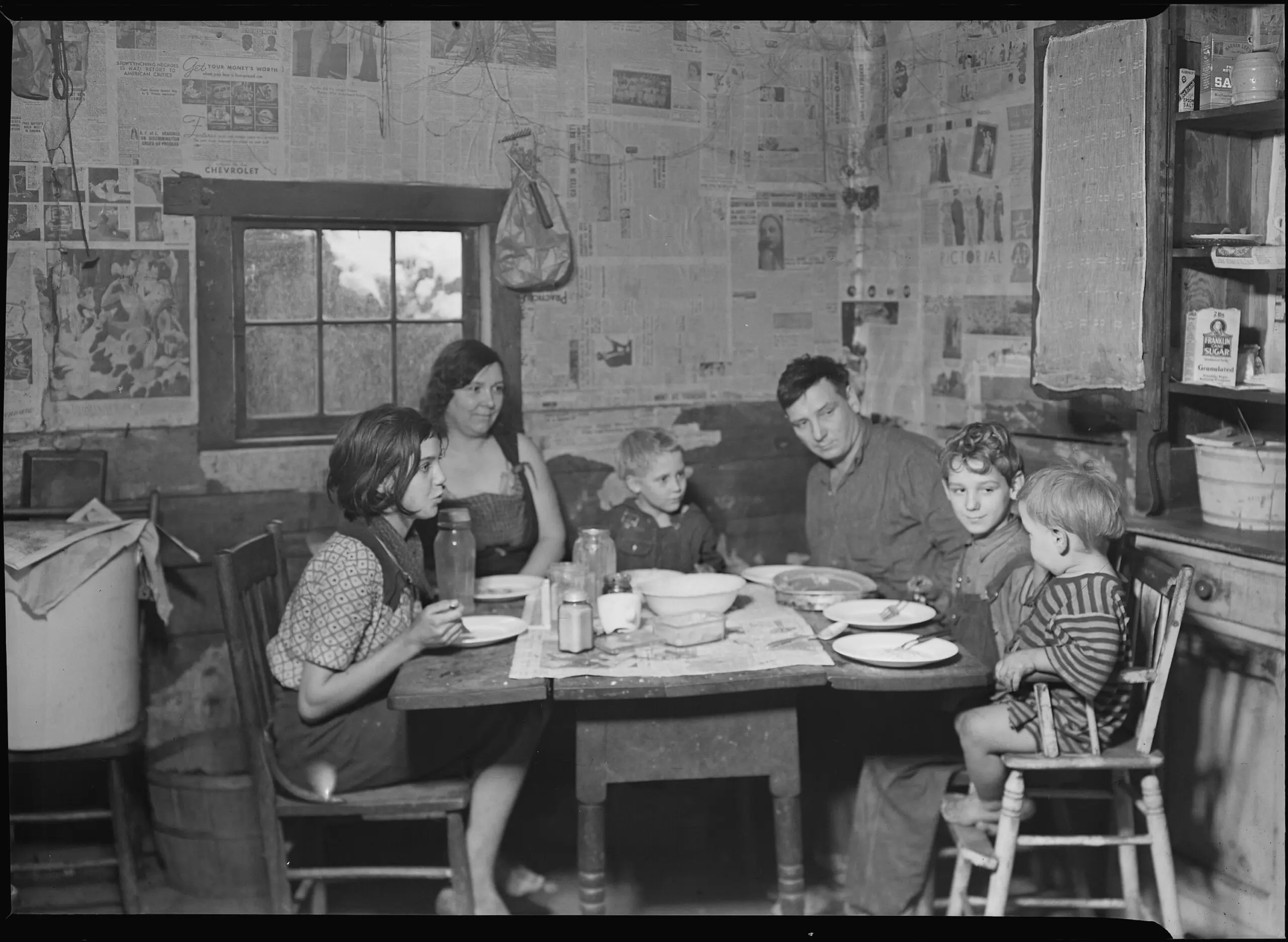
The image seen above shows a coal mining family in Scott’s Run, West Virginia. The photo seen above was taken on March 19, 1937. The image posted above is furnished courtesy of RoadRunner71 on the r/HistoryPorn forum on reddit.com
Later, the old wife fixed the three of us supper, then she helped her old husband into bed. After helping her old husband into bed, I sat with her in her living room that rested within an old unpainted house for a while. While sitting in that old couple, living room, I politely asked her why she stayed with her crippled husband for all of those decades, myself being overcome by curiosity as I was. Her response was, “Oh, I knew I could have any man I wanted. But, I had given my word and I wasn’t going back on it. Even though he was now confined to a wheelchair. Besides, I have always loved him just as much as I ever did.”
When the mines were at their height (Pre 1948, and before the establishment of Israel), the economy was controlled by Jews who moved in orbit around the House of Rothschild. Some of the local Rothschilds front organizations that controlled the local economy in the area where I lived included the L&N Railroad and the local independent bank which was actually dependent on larger Rothschilds-owned banks for its sustenance. Most of the population in my neck of the woods was either poor, or if they were fortunate, they might reach the level of being lower middle class as far as standards of living were concerned. The most profitable businesses in the parts where I grew up were all controlled by Jews, and the rest were dependent upon these few Jewish-controlled enterprises for their existence.
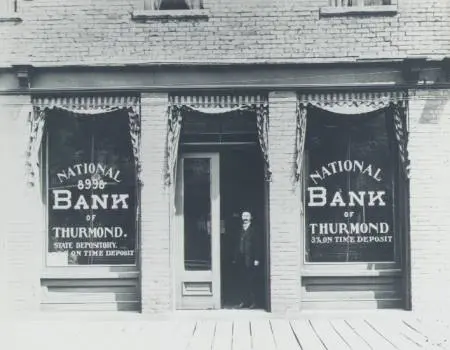
Image seen above shows the town bank in Thurmond, West Virginia in 1901. The image seen above is furnished courtesy of theclio.com
As was standard operating procedure in coal mining towns all over the United States, the miners were not actually paid in US currency, but instead, they were paid in company script. These company scripts could only be used at the Company Store (also run by Jews). This practice would eventually be declared illegal because it violated the constitutional amendment making slavery illegal, but these practices were only outlawed after the UMW (United Mine Workers) became strong enough to put sufficient pressure on the US Congress and the Supreme Court.
This is how it worked: A miner was charged by the mining company for his tools, his dynamite, and for whatever shoring he might need to prevent mine tunnels from collapsing. Miners were also charged for food, clothing, and housing for themselves and for their families. When a miner began working for a coal mine, he and his family would be broke, hungry, homeless, and desperate. Upon being hired, the coal company would advance a miner his pay so that he could begin working. After starting work, the miner had to pay back the cost of his working equipment with his next paycheck, then he was paid by the ton for whatever coal that he delivered to the mine entrance. Of course, there were always minimum quotas that were set by the mining company, so a group of miners would have to hire another miner to haul their coal to the mine entrance. No allowances were ever made for the time that was spent blasting and shoring, which was unpaid work.
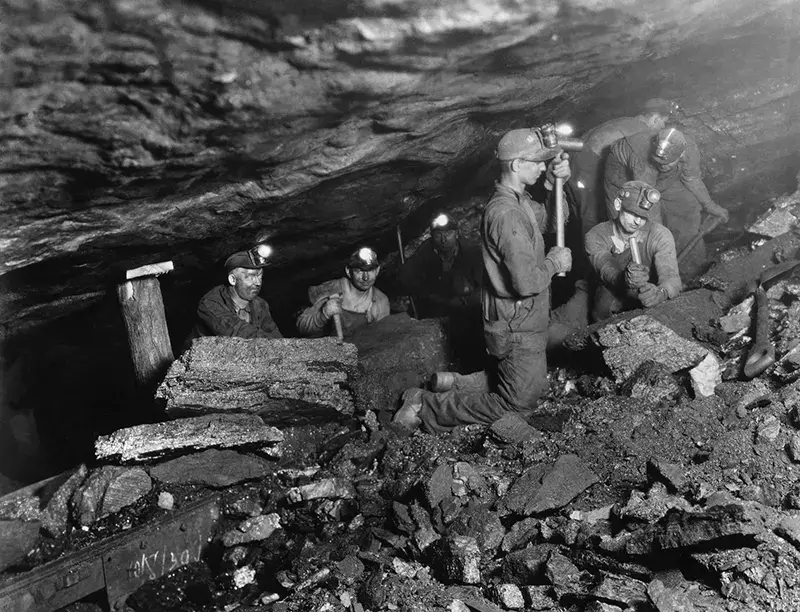
The image above shows coal miners at work in West Virginia around 1940. The image seen above is furnished courtesy of rarehistoricalphotos.com
Women and children were barred from ever entering the mines after a series of major disasters in the British Isles were attributed to the harsh employment conditions that were being foisted on women and children. The working conditions for women and children in British mines were so bad that this situation almost sparked a revolution back in the mid 19th Century. When pay day did finally roll around, a miner would once again be busted into being totally broke, so he would have to borrow from his employer again against his next paycheck. One can easily see how this engineered system of perpetual debt for coal miners was just another form of slavery.
For the miners, there was no reason to try and save anything because each company used their own script which was not convertible to regular currency. In addition, company stores would not accept payment in regular currency. My People were from a group known as Highland Farmers. Highland Farmers were people who made a living from subsistence farming on very small commercial-scale land holdings that rested high up in the mountains. Such people were fortunate enough to never need to work in the mines year-round, but they did work in the mines just between harvesting and planting seasons. These Highland Farmers were very much a minority group who also managed to escape from the curse of sharecropping which was yet another widespread form of slavery across the South.
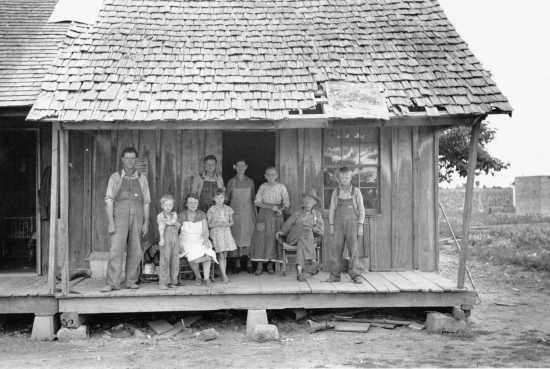
The image seen above shows a sharecropper family home in Missouri. The image above was taken in 1939. The photo above is provided courtesy of standard-democrat.com
When 1948 rolled around, the Jews controlled almost all the money in town. When the state of Israel was established, the Rothschilds shut the Appalachian coal mines down, and with the exception of one family, all of the local Jews pulled up stakes and headed off to Israel with the money which they had extracted from Appalachia. When the Jews left Appalachia, chronic poverty lingered in their wake.
There was one exception to this rule of Jews fleeing Appalachia after the founding of Israel, which I will include because it is an interesting case study, especially because I lived nearby and knew the family. This Jewish family had come to town so that the father could work as a clerk in a mining office. However, he grew so disgusted with how the Jews were treating the locals that he relocated his family to live among the locals and he began to speak up for the local people. This advocacy for the locals on the part of that Jewish man ended with that family renouncing their Jewishness and converting to Christianity, so the other Jews expelling them from The Tribe for this action. When the rest of the Jews headed out to Israel, this family stayed behind and was accepted into the local community who for obvious reasons really did hate Jews.
Part Five – Huey P. “Kingfish” Long and the World that Would Have Been
Huey P. Long was initially the Public Service Commissioner of Louisiana, and later he became the Governor of Louisiana. Long was wildly popular amongst the mostly impoverished general population of Louisiana, and Long was just as widely hated by the banks, the corporations, and by large landowners. The corporations accused Long of corruption after he began to prosecute these groups for swindling the people and swindling the state. Projection anyone? Long ended the feudal system that had been imposed on Louisiana by way of the Second American Revolution. Long also helped to rebuild and modernize Louisiana’s failing infrastructure. During his time as governor, Long began the long process of delivering Louisiana’s people away from the crushing poverty that had existed for so long.

The image above shows Huey P. Long gracing the cover of November 11th 1935’s issue of Time Magazine. The image above was taken while Long was running for governor of Louisiana. The image seen above is furnished courtesy of wikipedia.org
At some point during his career, Mussolini, who had been following the work of Huey Long, sent representatives to meet with “The Kingfish.” Recognizing a kindred spirit with Mussolini, Long was having to deal with a lot of the same problems that Mussolini was forced to deal with in Italy after he came to power, except there was no danger of a Bolshevik takeover in the state of Louisiana like there was in Italy. However, there was a lot of intense anger against the status quo that was boiling beneath the surface in Louisiana. Mussolini and Long became admirers of each other and Long began to introduce many of Mussolini’s reforms to Louisiana which turned out to be successful and very popular.
Considering what he did for the people of Louisiana, news began to spread all over The South about Governor Long. Despite facing circumstances that were similar to those which were encountered by Il Duche, though certainly not as extreme. Long’s popularity began to spread far and wide among the common people while he was governor of Louisiana, so he decided to make a run for the Presidency of the United States by running against FDR for the nomination of the Democratic Party’s front-running candidate. When looking back at Long’s run for president, we see a divide here between the Left Wing of the Democratic Party that was very much part and parcel in cahoots with International Jewry, and we also can see a Right Wing contingent within the same party that was similar in philosophy to the late-war Italian Social Republic which was headed by Mussolini. Once Long began his run for president, the rest of the country began to learn about Louisiana’s governor, so his popularity started to grow in disaffected parts of the country outside of the South.
Determined to end the threat that Long posed to the plans of the big-money interests which were backing FDR, the Democratic Party’s leadership refused to give Long access to party funds. By denying Long the funding that was needed to run for president, the Democratic Party effectively ended his bid for president; now, enter “The Louisiana Hayride.” The Louisiana Hayride was originally a very popular group of poor musicians and singers who toured Louisiana and other parts of the Deep South while performed from the back of a horse-drawn hay wagon.
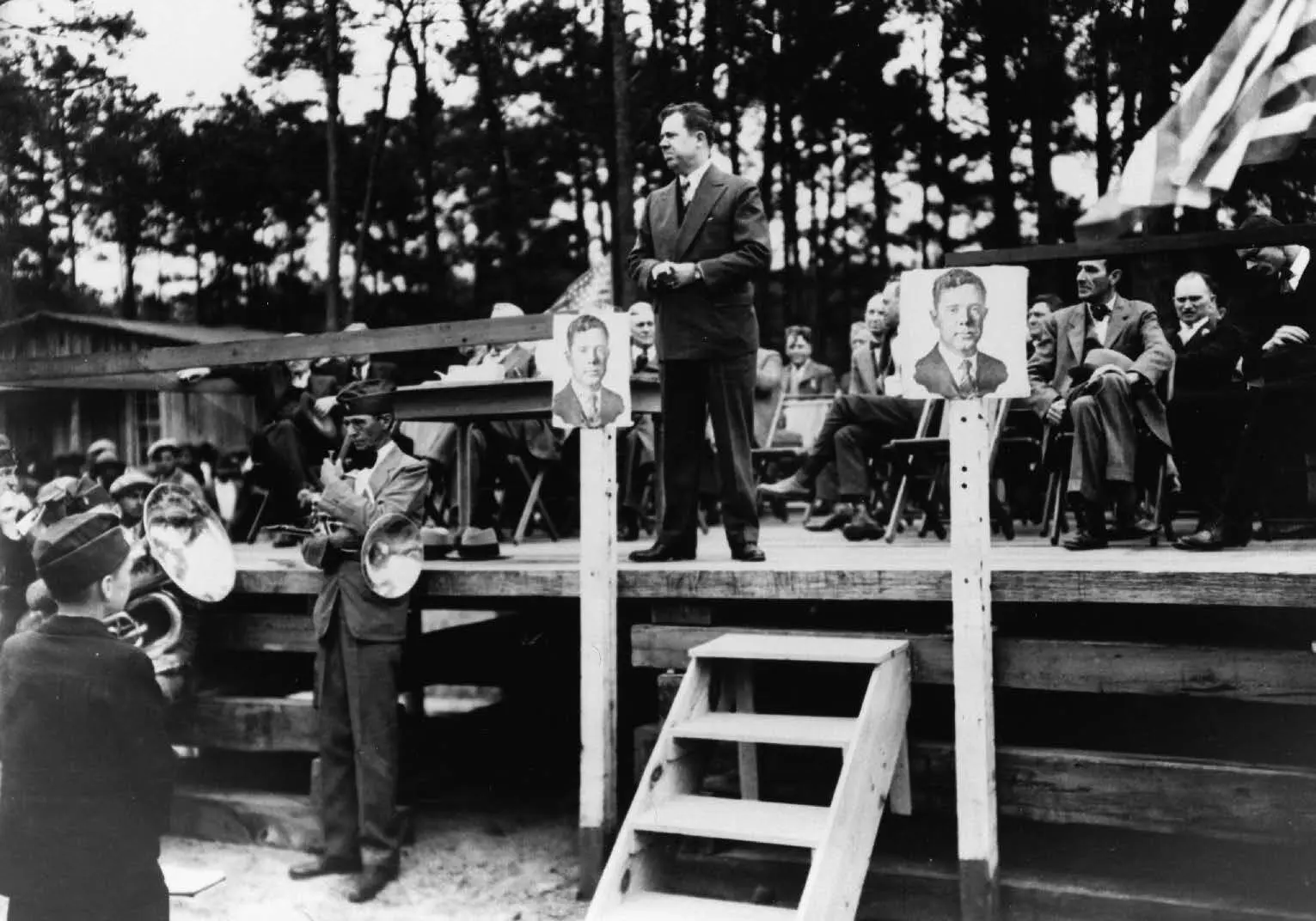
The image above shows Huey P. Long giving one of his low-budget campaign speeches to a relatively small crowd out in a rural area of the South. Despite being de-funded for making a larger campaign for president, it was these small and cheap speeches that actually built Long’s popularity despite his campaign’s lack of money. By giving many good speeches to small crowds out in rural areas, Long was able to build a grassroots base of support that grew by word of mouth. Despite lacking money and lacking support from the banks and corporations, Long still ran a surprisingly successful presidential campaign against the Jewish-backed Franklin Delano Roosevelt. The image seen above is furnished courtesy of cambridge.org
Huey P. Long’s Presidential Campaign ended up merging with “The Louisiana Hayride,” as a result of the Democratic Party’s leadership. Long campaigned across The South from the back of the same hay wagon that was used by the entertainers. After touring around the South and sometimes giving campaign speeches from a hay wagon, Long’s popularity exploded, first across the South, then across the whole country. Huey Long was very popular where I come from, and I spoke with a number of old coal miners who personally attended his rallies.
During the 1930s, the Republican Party had already totally discredited itself by its mishandling The Great Depression and events leading up to The Great Depression, so anybody that the Democrats ran was going to be the next President. We know what the Left Wing of The Democratic Party wanted during the 1930s because this is what we have now, but during the 1930s this bunch faced an existential threat from “The Kingfish.” Long was considered an existential threat by the Jewish-controlled member of the Democratic party because Long became so popular that he was a shoo-in for the Democratic Nomination, and even Long’s most bitter enemies recognized this fact.
Where I am from, talk of Bolshevism fell on deaf ears in contrast to what was faced by both Mussolini and Hitler; however, Long was seriously listened to despite his socialist tendencies. It has become my firm convection that a USA which exited under a Huey P. Long presidency would have surely aligned itself with Mussolini’s Italy, and Long actually said as much. With Il Duce acting initially as intermediary, I believe that the American Empire would have eventually aligned itself with the Third Reich as well. What then, a Quadripartite Agreement? Who knows what might have been if Long had become the American president, the sky would have been the limit, but such an alliance would have been a perfectly logical result of a Huey P. Long presidency.
One superrich American Jewish Bankers of Huey P. Long’s time is recorded as saying this about Huey P. Long: “We have an American Mussolini on our hands at the very least. He could easily turn into an American Hitler.” Very soon after beginning his Hay Wagon presidential campaign, “The Kingfish” was assassinated by two Jews. Both Jewish assassins were doctors, one was a shooter and the other was an emergency room doctor. The latter Jew had to finish the job that the first Jew had started. The Jewish first Jewish doctor was shot dead by one Long’s bodyguards who was armed with a .45 caliber Thompson sub machine gun. Long’s bodyguard tuned that scrawny little Jewish runt into a piece of Swiss cheese, but at that point the damage was done.
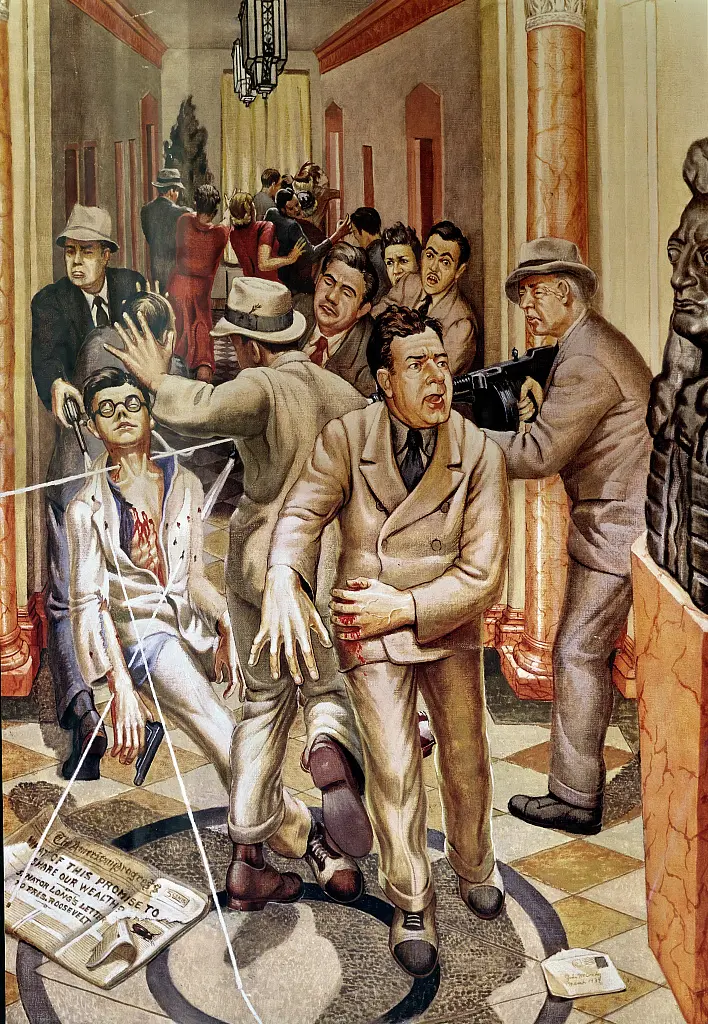
The image seen above is a painting commissioned by Life Magazine for the artist John McCrady. McCrady’s painting was commissioned to memorialize the assassination of Huey P. Long by the Jew named Carl Weiss now graces the state new state capital building of Louisiana in Baton Rouge.
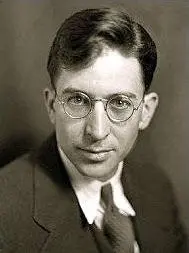
The image above shows Dr. Carl A. Weiss, the man who shot Huey P. Long inside the Louisiana State Capital building on September 8, 1935 at 9:20 AM inside the Louisiana state capital building.
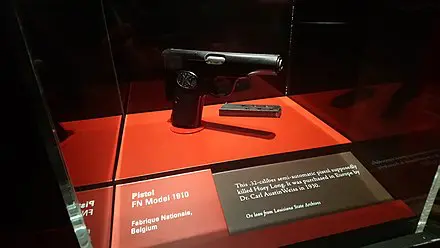
The pistol that was used to kill Huey P. Long is now on display in a glass case in the Old State Capital building in Baton Rouge. While serving as Louisiana’s governor, Long commissioned the construction of a new state capital building in Baton Rouse as of 1930 that is still in use to this day. The new state capitol building of Louisiana was finally given its dedication ceremony in May of 1932, and the Old State Capital building is now a museum. The image seen above is furnished courtesy of wikipedia.org
Epilogue – “The Miners Lady”
So, we come to the end of the story for now, but there are so many stories to tell which lie outside the parameters of this brief blog such as tales of Bigfoot and other Cryptids along with supernatural phenomenon such as UFO encounters, including my own personal encounter with a Vril type of flying disc. The Ku Klux Klan was once very active in the area I am from when I was young, so I can also share tales of a fight between local Home Guards (farmers) and a marauding band of Lincolnite Calvary that took place after the official closure of The War Between the States which left a strange brooding presence around the spot where that battle took place. I have so many more stories that I could share.
I will conclude now with a true story that was originally relayed in part to me by my Uncle Elbert, then I will show that Uncle Elbert’s tale is actually a very ancient and ongoing story. This tale from my uncle Elbert concerns “The Miner’s Lady.” The Miner’s Lady is also referred to in John Denver’s classic song “Country Roads.” The State of West Virginia also came to be called “The Miner’s Lady” because the Miner’s Lady has appeared in the mines of that area on so many occasions. The Miner’s Lady always appeared in the same fashion: A beautiful young woman is seen deep in a coal mine, and she is always young, she is always supernaturally beautiful, and she is always dressed resplendently.

Image of Hathor furnished courtesy of gathertales.com
The Miner’s Lady is always a Shining One who illuminates a mine shaft with her presence. Uncle Elbert had actually seen her. She has appeared in the coal mines all up and down the Appalachians. At one time, she had a particular affinity for the Irish coal miners of Eastern Kentucky who took her to be a Faery Woman that had followed them over from The Old Country. The Miner’s Lady always appeared when things were at their worst, then afterwards, things would always get significantly better. She was seen as The Guardian Spirit of the Coal Miners of Appalachia.
Before any coal was ever dug in Appalachia, the Miner’s Lady was already well known to the miners of the British Isles, but she has traveled much further afield than that. The coal miners of Germany had for centuries been acquainted with this mysterious young lady as well.
For her origin, we must go all the way back to the Most Ancient Pre-Pharaonic Egypt, to the Tep Tepe, The First Time, the time when the Neteru literally walked amongst men; however, the Gods & Goddesses of Egypt NEVER called themselves gods or goddesses when they were actually present. This mysterious group would only refer to themselves as Neteru (plural) or Neter (singular). The Neteru and the Neter harken back to a time when the Egyptians were a fair-skinned, red-haired, and blue-eyed Aryan people which was a time untold thousands of years ago.
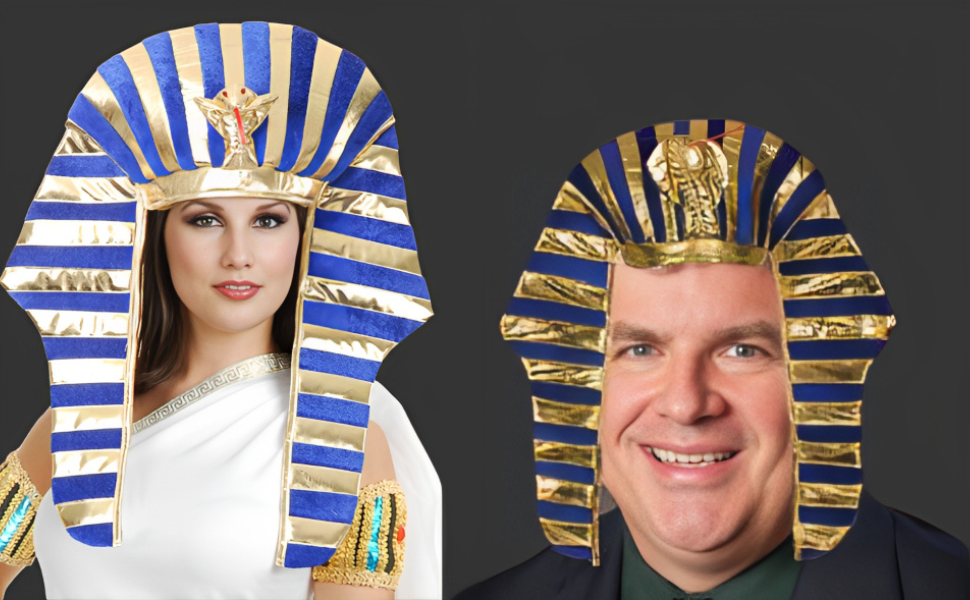
Image courtesy of Windy City Novelties on Amazon.com
Among the Neteru, there was a woman who was renowned throughout the land as the most beautiful woman in all of Egypt whether Neteru or mortal, but her beauty was not all that she was renowned for. This woman was not only beautiful, but she always showed the most enlightened benevolence towards all that she encountered. Her name was HATHOR.
The astounding metalworking of the most Ancient Egyptians was done in gold, in silver, and in bronze, and I have seen examples of their gold-work myself. Ever wonder what the old Egyptians used to smelt metal ores? Ever wonder what their source of heat was? It certainly was not wood because Egypt never exactly had an abundance of trees. Well, the answer is Coal. The Egyptian Coalfields lay in a portion of the land which lies between the Nile River and the Red Sea.
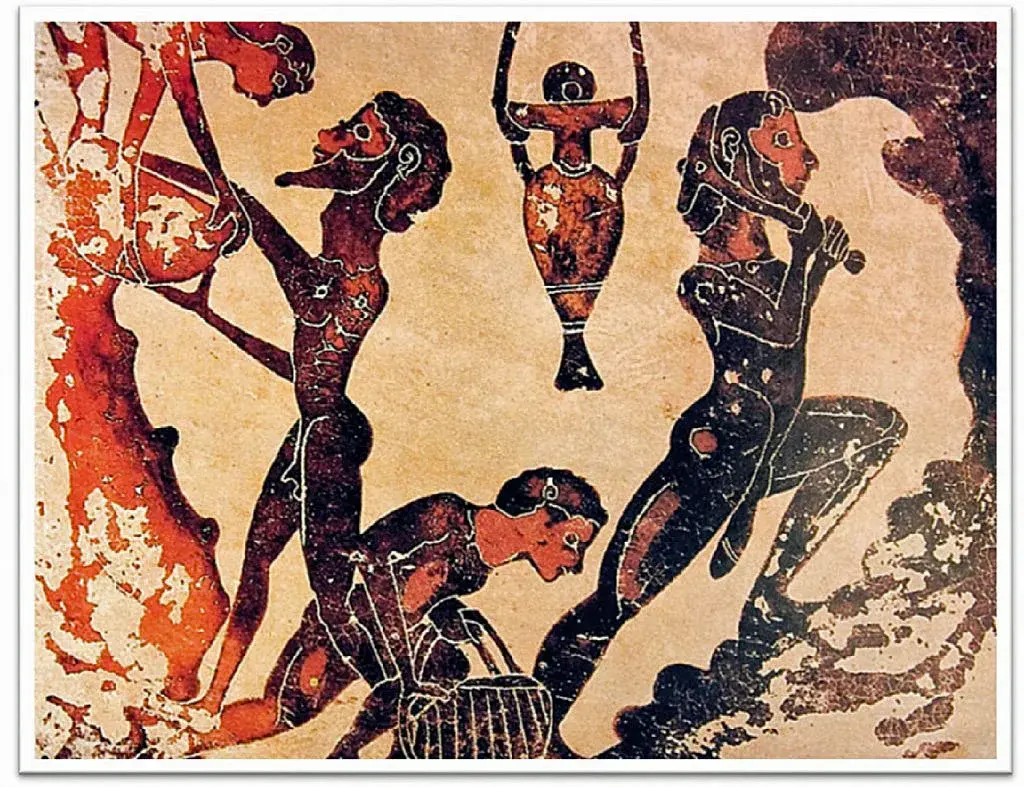
Underground mining for metals and coal was done in ancient Greece and during the Roman era. Many Greek paintings and vases have survived to this day that document slaves working in underground mines of various types. The image seen above is furnished courtesy of depositsmag.com
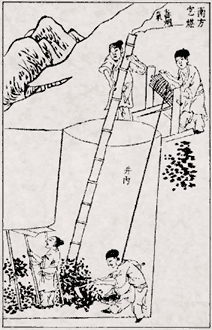
The image seen above shows old Chinese coal mining techniques that stretch back to around 1000 B.C. According to archaeologists, China has been making use of coal for metal working, heating, and cooking for at least 6,000 years, but dedicated underground mines did not really become common unit around 1,000 B.C. Before underground mines were developed, coal was just collected from the ground and open pits were dug to extract whatever coal was near the surface. The image posted above was drawn in 1637, but it illustrates traditional mining methods that go back much further. The image seen above is furnished courtesy of wikipedia.org
Even then, mining was a dangerous occupation for a man. The Ancient Egyptians knew about all the old killers that still kill coal miners up to this very day. These age-old causes of death for coal miners include cave ins, methane exposure, and coal dust explosions along with having water blow back into a mine when inadvertently working a bit too close to a river or the sea, and oh yes, let us not forget Black Lung. So many of these age-old causes of death for coal miners happen because the miners are being pressured to produce too much too coal quickly.
Given how bad mining conditions were in old Egypt, a delegation of Egyptian coal miners went to the Neteru and told them in essence, “Change things so that we can work safely or we are not digging any more coal. We do not care what you do to us because we are already doomed as it is. You are making these demands of us because none of you have any idea what mining is like. None of you will enter the mines.”
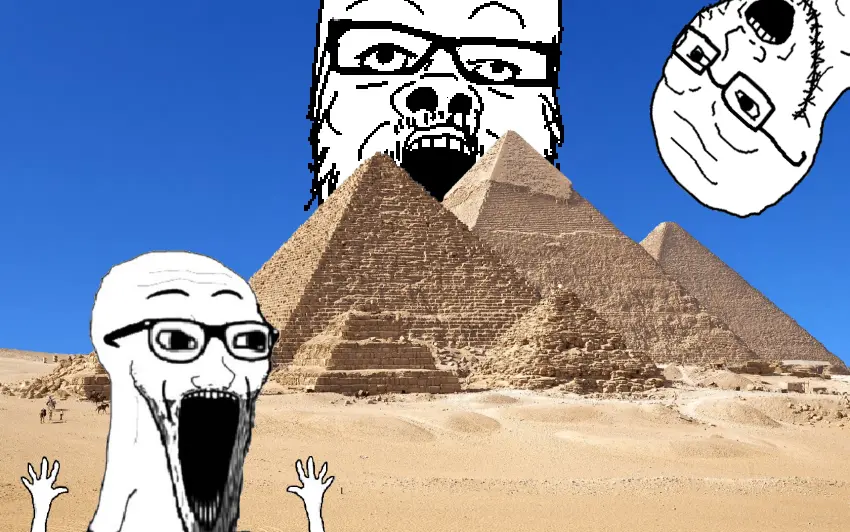
Image courtesy of knowyourmeme.com
After they departed, the Neteru all gathered together and discussed the looming strike. After hearing the miner’s make their petition, the Netaru all agreed that they really had no understanding of what they were demanding these miners do, but what to do, they asked each other.
Having been deeply moved by hearing the miner’s petition, Hathor stepped forward and said, “I’ll go into the mines where they are working, then I will report back to everybody.”
The miners were truly shocked to see this radiant one appearing in the bottoms of the mines where they worked. Hathor stayed with the miners for some length of time while watching them work and deciding what to do next. Finally, she returned to the other Neteru after they had once again gathered together. Hathor relayed what she had seen during her stays in the coal mines, then she proposed that the Neteru accede to the miners demands because these demands were righteous and the Neteru should always govern in an enlightened manner.
After hearing Hathor speak upon her return from the mines, the other Neteru agreed to her proposal, so that the Egyptian Civilization could continue to advance without interruption and advance even more rapidly than it had before. The miners, soon came to understand that if they had a problem, then they could take their grievances to Hathor and have their concerns addressed in a righteous manner.
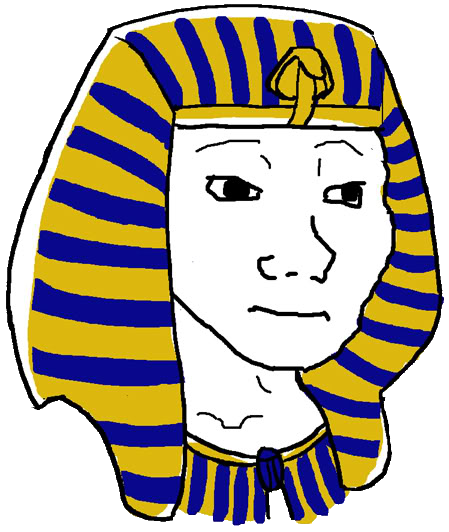
Image courtesy of wojakland.com
In light of her good deeds, the Egyptian coal miners nicknamed her “The Miners Lady.” The name “Miner’s Lady” obviously stuck from Egypt forward, including across Germany and the British Isles all the way to Appalachia. The later miners, like my Uncle Elbert, did not know exactly the Miner’s Lady was, nor did they know from whence she came, but their descriptions of her and her behavior precisely match those of the most Ancient Egyptians. Truth is indeed, stranger than fiction.
Heil Hitler deva!
Randall Lee Hilburn
